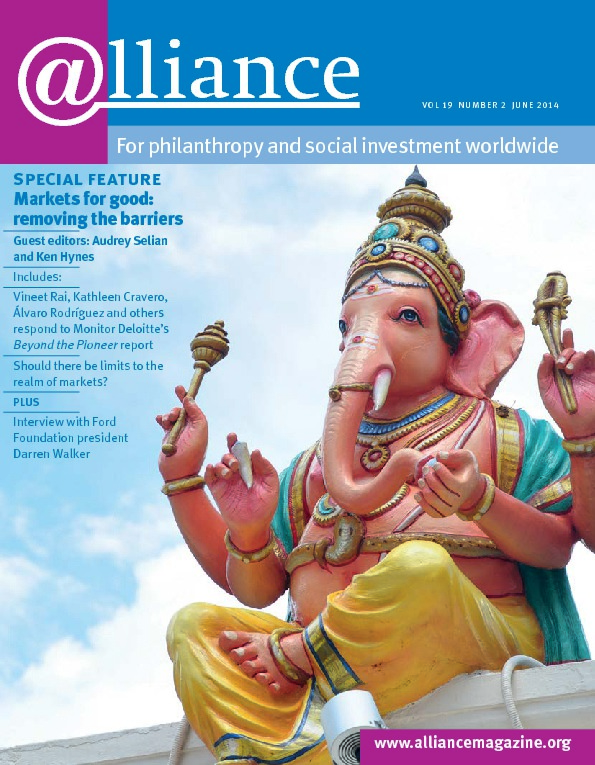Look around and most likely you know a friend, family member or neighbour who has a disability. Yet in many parts of the world, people with disabilities are chained to a tree for years on end or locked away in a room and given only the scraps of the family meal to eat. The World Health Organization estimates that people with disabilities are the world’s largest minority – 1 billion people. In the developing world, they make up 20 per cent of the poorest of the poor. Nine out of ten children with disabilities don’t attend school. Women with disabilities face an unemployment rate of virtually 100 per cent. Yet a recent survey of foundations by the Foundation Center and International Human Rights Funders Group (IHRFG) found that just $40 million of over $1 billion in human rights funding includes people with disabilities. It’s not enough.
With the adoption of a new international treaty, the Convention on the Rights of Persons with Disabilities (CRPD), there are signs of positive change. In September 2013, the UN General Assembly held its first ever high-level meeting on disability. US Secretary of State John Kerry noted that US anti-discrimination laws have helped put 60 per cent of students with disabilities in general education classrooms. Some donors are beginning to recognize disability as a human rights issue, thanks to evolving international standards such as the CRPD and the activism of disabled persons’ organizations and human rights groups like Human Rights Watch. Human rights advocates have the potential to dismantle exclusionary practices – if donors invest more.
So why don’t they? Over and over, I hear the same objections: ‘We don’t understand the issues.’ ‘In this economy, we just can’t add another identity group/issue.’ ‘Our grantmaking strategies aren’t formulas based on a census.’ Let me address these points.
First, if you understand the issues of any other marginalized group, such as women or people of colour, the issues faced by people with disabilities will sound very familiar: exclusion based on identity, systematic prejudice in both law and practice, lack of opportunities to participate in decisions that affect them. Simple disability awareness training, conducted by people with disabilities, can be an incredible eye opener and increase staffs’ willingness and enthusiasm to address disability exclusion. Resources are already available to guide donors on how to make grantmaking accessible.[1]
Second, people with disabilities are not a ‘new’ community separate from immigrants, women, children, LGBTI, etc. Most of us have multiple identities and for many, intersections of stigma, prejudice and opportunity are created. If you look closely at the communities with whom you work, you will certainly see people with disabilities among them.
Third, disability rights should be funded no matter what group is involved given that people with disabilities make up at least 15 per cent of the population. In fact, I would argue that funding for marginalized populations should be higher than their proportion of the population given the extreme poverty, exclusion and rights violations they face.
Lastly, I often hear you need specific expertise for this type of grantmaking. My own experience contradicts this. I knew little about the world of disability rights when I first started making grants in the field. Yet, it was a natural fit to apply a human rights frame to disability issues. More importantly, I found amazing leaders with disabilities to help me learn. And it can work. The Disability Rights Fund, a collaborative of donors and activists, shows this. When Maria Alejandra Villanueva, a young woman in Peru with Downs Syndrome, went to vote in 2011, she was turned away from the polls. With a grant of $20,000 from DRF, the Peruvian Downs Syndrome Society advocated for and won the reinstatement of voting rights for more than 23,000 people with intellectual and psychosocial disabilities.
I challenge human rights donors to carefully examine the mission, values and grantmaking strategies of your institutions. Have your staff been trained on disability inclusion? Have you consulted with people with disabilities about how the programmes you support could include people with disabilities? Could you dedicate funding exclusively to support their rights? Donors truly committed to equality cannot ignore people with disabilities. As Jay Ruderman of the Ruderman Family Foundation wondered in the Jerusalem Post: ‘What kind of just society have we created if one-fifth of it is separated and looking in from the outside?’
1 See Beyond Charity: A donor’s guide to inclusion
Catherine Townsend is a programme officer at Wellspring Advisors. chtownsend@wellspringadvisors.com






Comments (0)